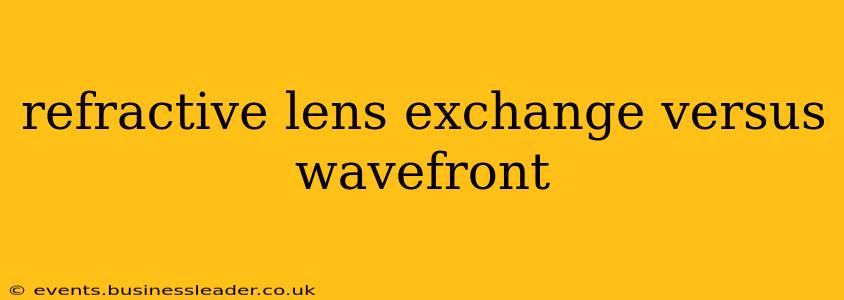Choosing between Refractive Lens Exchange (RLE) and Wavefront-Guided LASIK can feel overwhelming. Both procedures aim to correct refractive errors like nearsightedness (myopia), farsightedness (hyperopia), and astigmatism, allowing you to see clearly without glasses or contact lenses. However, they differ significantly in their approach, candidacy, and long-term outcomes. This comprehensive guide will delve into the key differences to help you make an informed decision.
What is Refractive Lens Exchange (RLE)?
RLE, also known as clear lens extraction, is a surgical procedure where your natural eye lens is removed and replaced with an artificial intraocular lens (IOL). This IOL is permanently implanted, correcting your refractive error and eliminating the need for glasses or contacts. RLE is particularly suitable for individuals with cataracts or those who are at high risk of developing cataracts. Even without cataracts, RLE is an option for those who want to be free from glasses or contacts and are within the appropriate age range.
What is Wavefront-Guided LASIK?
Wavefront-Guided LASIK is a type of laser eye surgery that reshapes the cornea, the clear front part of your eye, to correct refractive errors. Unlike traditional LASIK, Wavefront-Guided LASIK uses advanced technology to create a highly personalized treatment plan based on a detailed map of your eye's unique imperfections. This personalized approach aims for superior visual accuracy and reduced aberrations, leading to potentially better visual outcomes.
RLE vs. Wavefront-Guided LASIK: Key Differences
| Feature | Refractive Lens Exchange (RLE) | Wavefront-Guided LASIK |
|---|---|---|
| Procedure | Removal of natural lens and implantation of an IOL | Reshaping of the cornea using a laser |
| Age Suitability | Generally more suitable for older individuals (40+ often preferred, though age ranges vary by individual and surgeon) | Generally more suitable for younger individuals, but this range also has upper limits. |
| Cataracts | Treats cataracts as well as refractive errors | Does not treat cataracts |
| Corneal Health | Less demanding on corneal health, suitable for thinner corneas | Requires sufficient corneal thickness |
| Recovery Time | Generally longer recovery time than LASIK | Generally faster recovery time than RLE |
| Long-Term Stability | Typically very stable long-term results | Possible need for touch-up procedures, though advancements and meticulous selection process helps greatly minimize that |
| Risk of Complications | Potential risks include infection, inflammation, and IOL dislocation, though these are relatively uncommon | Potential risks include dry eyes, flap complications, and infection, though these are generally low |
What are the advantages of RLE?
- Correction of both cataracts and refractive errors: RLE addresses both conditions simultaneously.
- Long-term stability: The implanted IOL typically provides stable vision for many years.
- Suitable for thinner corneas: RLE is an option for individuals whose corneas are too thin for LASIK.
What are the advantages of Wavefront-Guided LASIK?
- Faster recovery time: Vision often improves more quickly after LASIK than after RLE.
- Preservation of the natural lens: The natural lens is preserved, which some view as an advantage.
- Potentially better visual acuity: The personalized approach may result in sharper vision in some cases.
Which procedure is right for me?
The best procedure for you depends on several factors, including your age, the severity of your refractive error, the health of your cornea, and the presence of cataracts. A comprehensive eye examination by an ophthalmologist is crucial to determine your candidacy for either procedure. They will assess your individual needs and discuss the potential benefits and risks of each option. This consultation will be key to helping you decide which is best for your specific situation.
What are the potential risks and side effects of RLE and Wavefront-Guided LASIK?
RLE potential risks and side effects: These include infection, inflammation, posterior capsule opacification (clouding of the lens capsule), and IOL dislocation. These are generally rare and effectively managed by ophthalmologists, but it is important to be aware of them.
Wavefront-Guided LASIK potential risks and side effects: These include dry eyes, flap complications (in cases of flap-based LASIK procedures), infection, and under- or over-correction. Again, these complications are uncommon, and surgeons take extensive steps to minimize these risks.
Is RLE more expensive than Wavefront-Guided LASIK?
The cost of both procedures can vary depending on several factors, including the surgeon's fees, the technology used, and geographic location. In many cases, the procedures are comparable in cost, though this may also vary by locale and individual surgeon. It's important to get a detailed breakdown of costs from your ophthalmologist to be completely prepared.
How long does it take to recover from RLE and Wavefront-Guided LASIK?
Recovery time differs between the two procedures. LASIK generally has a faster recovery, with most patients experiencing significant improvement within a day or two. RLE typically involves a longer recovery period, with vision stabilizing over several weeks or months. Again, your ophthalmologist will provide a specific timeline based on your individual circumstances.
This information is for educational purposes only and is not a substitute for professional medical advice. Always consult with a qualified ophthalmologist to discuss your individual needs and determine the best course of action for your specific situation.
